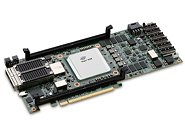Thursday, September 19th 2019

Intel Ships Stratix 10 DX FPGAs, VMWare Among Early Partners
Intel today announced shipments of new Intel Stratix 10 DX field programmable gate arrays (FPGA). The new FPGAs are designed to support Intel Ultra Path Interconnect (Intel UPI), PCI-Express (PCIe) Gen4 x16 and a new controller for Intel Optane technology to provide flexible, high-performance acceleration. VMware is one of many early access program participants.
"Intel Stratix 10 DX FPGAs are the first FPGAs designed to combine key features that dramatically boost acceleration of workloads in the cloud and enterprise when used with Intel's portfolio of data center solutions. No other FPGA currently offers this combination of features for server designs based on future select Intel Xeon Scalable processors," said David Moore, Intel vice president and general manager, FPGA and Power Products, Network and Custom Logic Group.Stratix 10 DX FPGAs with the new interfaces include the option to support select Intel Optane DC persistent memory dual in-line memory modules (DIMMs). They dramatically increase bandwidth and provide coherent memory expansion and hardware acceleration for upcoming select Intel Xeon Scalable processors.
Data center customers increasingly use hardware accelerators, like FPGAs, when more computational speed is required from server systems running networking and cloud-based applications such as artificial intelligence training/inferencing or database-related workloads. The effective performance of hardware accelerators depends heavily on the communications bandwidth and latency between one or more server CPUs, available system memory and any attached accelerator (GPU, FPGA, application-specific standard products, etc.).
By diverting certain tasks to accelerators, more CPU cores become available to work on other higher priority workloads, increasing data center operator efficiency. Intel's FPGA-based accelerators provide hardware-assisted performance combined with the flexibility to adapt to multiple workloads.
"VMware and Intel have a long history of developing and delivering innovative solutions to the industry. As part of this continued partnership, VMware is collaborating with Intel to develop coherent FPGA and CPU acceleration solutions. Our mutual customers demand high-performing, easy-to-use and reliable infrastructure, both on-premises and in the cloud. Intel is a great partner to us in helping deliver this," said Krish Prasad, senior vice president and general manager, Cloud Platform Business Unit at VMware.
When compared with previous FPGA variants, Intel believes that Intel Stratix 10 DX FPGAs will provide new capabilities and interface features including:
"Intel Stratix 10 DX FPGAs are the first FPGAs designed to combine key features that dramatically boost acceleration of workloads in the cloud and enterprise when used with Intel's portfolio of data center solutions. No other FPGA currently offers this combination of features for server designs based on future select Intel Xeon Scalable processors," said David Moore, Intel vice president and general manager, FPGA and Power Products, Network and Custom Logic Group.Stratix 10 DX FPGAs with the new interfaces include the option to support select Intel Optane DC persistent memory dual in-line memory modules (DIMMs). They dramatically increase bandwidth and provide coherent memory expansion and hardware acceleration for upcoming select Intel Xeon Scalable processors.
Data center customers increasingly use hardware accelerators, like FPGAs, when more computational speed is required from server systems running networking and cloud-based applications such as artificial intelligence training/inferencing or database-related workloads. The effective performance of hardware accelerators depends heavily on the communications bandwidth and latency between one or more server CPUs, available system memory and any attached accelerator (GPU, FPGA, application-specific standard products, etc.).
By diverting certain tasks to accelerators, more CPU cores become available to work on other higher priority workloads, increasing data center operator efficiency. Intel's FPGA-based accelerators provide hardware-assisted performance combined with the flexibility to adapt to multiple workloads.
"VMware and Intel have a long history of developing and delivering innovative solutions to the industry. As part of this continued partnership, VMware is collaborating with Intel to develop coherent FPGA and CPU acceleration solutions. Our mutual customers demand high-performing, easy-to-use and reliable infrastructure, both on-premises and in the cloud. Intel is a great partner to us in helping deliver this," said Krish Prasad, senior vice president and general manager, Cloud Platform Business Unit at VMware.
When compared with previous FPGA variants, Intel believes that Intel Stratix 10 DX FPGAs will provide new capabilities and interface features including:
- The UPI interface in combination with future select Intel Xeon Scalable processors will deliver 37% lower latency2 and improve overall system performance via coherent data movement and a theoretical peak transfer rate of 28 GB/second3. Memory coherent FPGA interfaces are part of Intel's roadmap as we move toward Compute Express Link availability in 2021.
- PCI-SIG compliant Gen4 x16 interface delivers a theoretical peak data bandwidth of 32 GB/second. Both data center and non-data center applications will realize about two times more throughput4.
- Memory controller supports up to eight Intel Optane DC persistent memory modules per FPGA (up to 4 TB of non-volatile memory).
- Other existing Stratix 10 FPGA features include 100 GB/second Ethernet, HBM2 memory stacks and a quad-core ARM Cortex-A53 processor subsystem with peripherals.



8 Comments on Intel Ships Stratix 10 DX FPGAs, VMWare Among Early Partners
Or at least, that's what the fanbois here were claiming...
This thread. I can't.
X570 has shown that PCIe 4.0 is not a consumer-friendly technology yet. It takes way too much power and emits way too much heat. But neither is a problem in datacenters and high-end workstations.
Remember that in consumer segment Intel focuses on mobile CPUs.
As fast PCIe controllers become more consumer-friendly, Intel will put them into consumer platforms as well.
Either way, what's interesting about this part, is the PCIe 4.0 is a separate chip connected across EMIB (UPI protocol - replacement for Intel QPI). If anything, this is probably for customers who want a PCIe4.0-based accelerator (which this is for) on EPYC or POWER9 systems (POWER9 has had PCIe 4.0 for at least a couple years now).
This is Intel simply attaching the PCIe 4.0 chip they originally designed for their 10nm FPGAs, to an existing 14nm FPGA (the 14nm FPGA got an UPI link from another project to integrate a FPGA onto the same package as an Intel CPU). This way, customers on existing PCIe 4.0 systems can benefit from higher speed interconnects for their accelerators. Their (already shipping) 10nm FPGAs have PCIe 5.0 + CXL on external chips, too.